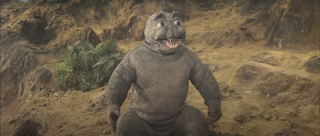directed by Jun Fukuda
Japan
85 minutes
4.5 stars out of 5
----
Son of Godzilla, despite being a bombastic, colorful, and incredibly well-made movie, was apparently disliked by audiences enough that Toho considered ending the series afterward. This was the height of the kaiju boom in Japan: as I mentioned in my Space Monster Wangmagwi review, 1967 saw every major film studio produce a kaiju movie. But every bubble must burst, and the burgeoning success of Ultraman and Ultraseven signaled a shift towards television that would leave film studios struggling to raise theater attendance. For now, though, this is Toho at the top of their game.
Visually - and sonically, Masaru Satō's score is genuinely one of the best soundtracks ever put to film - this movie is such a delight. It was filmed on location in Guam (you can tell because everybody is really tan), so there's no shortage of jungle scenes that are more convincing than anything achieved even on one of Toho's reality-defying open sets, but it's the miniatures that shine the most here. I love the cohesive look of it all. There's something about the brightly-colored structures the scientists live and work in that almost feels a little... dreamlike, perhaps, like an idea that a child might have of what doing science is like.
The editing and compositing here is some of Toho's finest, I believe. This is my fourth rewatch of the film, and it seems like lately when I've been rewatching Godzilla movies I've really been taking notice of the way scale is achieved. I'm thinking about a scene where Godzilla blasts one of the Kamacuras with his atomic breath and a piece of it goes flying off and lands, flaming, while the tiny-in-comparison human characters flee. The optical printing is remarkably well done here, and shots of puppets - small in reality but made convincingly huge - superimposed over the jungle landscape look great. The creative editing even extends to the human story too: I love that scene after the weather balloon experiment fails spectacularly where we hear Fujisaki narrate everything that's gone wrong on the island over a montage of floods and storms, and then it cuts to him writing about it in a journal. That was just such a unique way to structure a narrative moment meant to immerse us further in the environs of the film.
I recently read an article talking about the way science has been used throughout the Godzilla series that I thought was really interesting, and it highlighted this movie in specific and how it has a very different view on the use of science to assert mastery over nature than a lot of previous films. In short, while doing experiments does give rise to monsters - Kamacuras and Kumonga - and cause the weather on the island to go haywire, the thing that stops all of that is just doing more science. The solution to messing things up through your experimentation is to experiment harder. This is a strikingly optimistic viewpoint in contrast to the often dismal opinion of scientific interference with nature that many Godzilla films hold, although if you think too hard about what the people on Solgel Island are doing, they do still seem a little arrogant: it's for the greater good, but they are wrecking the ecosystem of an island which had up until then been in balance, and that includes the other living creatures on it. Kamacuras is as much a product of man's meddling with nature as the original Godzilla was, but Kamacuras is portrayed in a far less sympathetic light than Godzilla.
I will admit this is not my favorite Godzilla suit, but Hiroshi Sekita's performance makes me not care about how the suit looks. Sekita was chosen instead of Haruo Nakajima - Godzilla's default suit actor, pretty much - because he was taller than Nakajima and the film's producers wanted to create more contrast between Godzilla and Minilla. I can't source this because I don't recall where I read it, but apparently Sekita would speak to Minilla while in the suit (either out loud or in his head), narrating what Godzilla would be saying to his son: instructions on how to use his atomic breath, admonishments on venturing into dangerous parts of the island, et cetera. There is consistently so much effort put into bringing Godzilla to life as a character. I will talk about this until I'm blue in the face because for so long bad dubs and a lack of attention caused the Godzilla series to be regarded as "goofy rubber monster movies".
I understand how jarring this movie must seem when you consider the idea of Godzilla as a bringer of misery and pain, as he had been in his first two films (and would be again). But to me the thing that's so, so fascinating about Godzilla as a character, and why he has proved so enduring, is this: there's what Godzilla is - a stand-in for the looming threat of nuclear annihilation, depicted as such with varying degrees of fervency depending on whether you're going off Kayama's original idea for him or Honda's interpretation - and then there's what you do with him. In large part, this transition away from Godzilla as a force of terror and dread was due to Toho recognizing that their biggest audience was children, and so the people who made movies like this maybe did not necessarily want to make them this way - but they did. Godzilla as a cultural icon survived this long precisely because he has changed, and will continue to, but at the same time, there's always been a core concept that has remained throughout all of his iterations. There's no denying that there is a solid idea of What Godzilla Is, but, conversely, it also must be recognized that there's a What Godzilla Can Be.


No comments:
Post a Comment